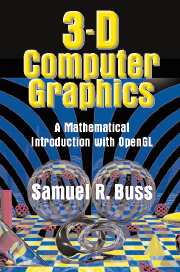Book contents
- Frontmatter
- Contents
- Preface
- I Introduction
- II Transformations and Viewing
- III Lighting, Illumination, and Shading
- IV Averaging and Interpolation
- V Texture Mapping
- VI Color
- VII Bézier Curves
- VIII B-Splines
- IX Ray Tracing
- X Intersection Testing
- XI Radiosity
- XII Animation and Kinematics
- A Mathematics Background
- B RayTrace Software Package
- Bibliography
- Index
- Plate section
IV - Averaging and Interpolation
Published online by Cambridge University Press: 05 June 2012
- Frontmatter
- Contents
- Preface
- I Introduction
- II Transformations and Viewing
- III Lighting, Illumination, and Shading
- IV Averaging and Interpolation
- V Texture Mapping
- VI Color
- VII Bézier Curves
- VIII B-Splines
- IX Ray Tracing
- X Intersection Testing
- XI Radiosity
- XII Animation and Kinematics
- A Mathematics Background
- B RayTrace Software Package
- Bibliography
- Index
- Plate section
Summary
This chapter takes up the subject of interpolation. For the purposes of the present chapter, the term “interpolation” means the process of finding intermediate values of a function by averaging its values at extreme points. Interpolation was already studied in Section II.4, where it was used for Gouraud and Phong interpolation to average colors or normals to create smooth lighting and shading effects. In Chapter V, interpolation is used to apply texture maps. More sophisticated kinds of interpolation will be important in the study of Bézier curves and B-splines in Chapters VII and VIII. Interpolation is also very important for ianimation, where both positions and orientations of objects may need to be interpolated.
The first three sections below address the simplest forms of interpolation; namely, linear interpolation on lines and triangles. This includes studying weighted averages, affine combinations, extrapolation, and barycentric coordinates. Then we turn to the topics of bilinear and trilinear interpolation with an emphasis on bilinear interpolation, including an algorithm for inverting bilinear interpolation. The next section has a short, abstract discussion on convex sets, convex hulls, and the definition of convex hulls in terms of weighted averages. After that, we take up the topic of weighted averages performed on points represented in homogeneous coordinates. It is shown that the effect of the homogeneous coordinate is similar to an extra weighting coefficient, and as a corollary, we derive the formulas for hyperbolic interpolation that are important for accurate interpolation in screen-space coordinates.
Information
- Type
- Chapter
- Information
- 3D Computer GraphicsA Mathematical Introduction with OpenGL, pp. 99 - 125Publisher: Cambridge University PressPrint publication year: 2003
